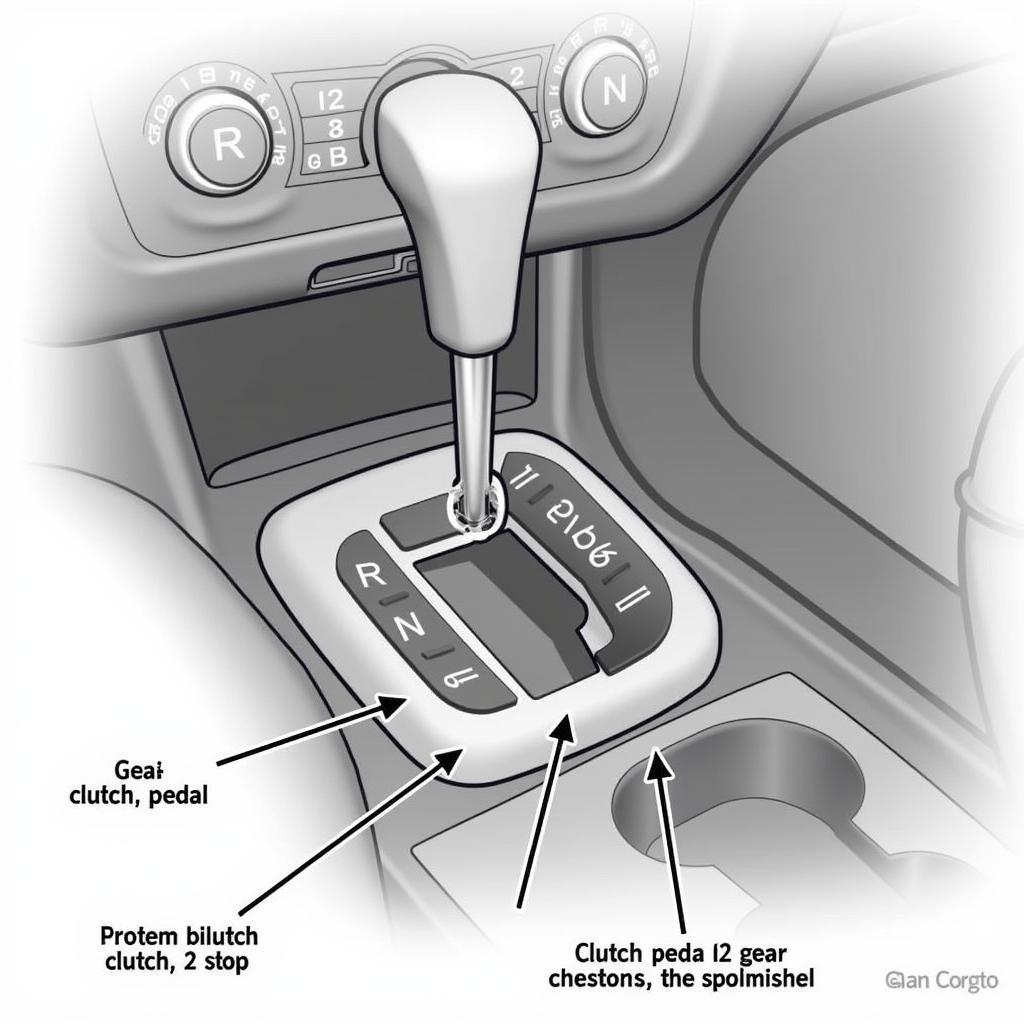Driving a manual transmission car, often referred to as a stick shift, can seem daunting at first. This guide provides a thorough understanding of how to operate a manual car, from the basics to more advanced techniques, empowering you to confidently navigate the roads.
Understanding the Basics of a Manual Transmission
Before hitting the road, it’s essential to familiarize yourself with the components of a manual transmission. Unlike automatic cars, manual vehicles require the driver to actively select gears to match the engine’s speed and the car’s velocity. Key components include the clutch pedal, gear stick, and the gas pedal. The clutch pedal disengages the engine from the wheels, allowing you to change gears smoothly. The gear stick selects the appropriate gear, while the gas pedal controls the engine’s speed. Mastering the coordination of these three components is the foundation of driving a manual car.
 Manual Car Components: Clutch, Gear Stick, and Gas Pedal
Manual Car Components: Clutch, Gear Stick, and Gas Pedal
Starting the Car and Getting into First Gear
With the engine off, press the clutch pedal all the way down. Next, insert the key and turn the ignition. Make sure the gear stick is in neutral, which is usually indicated by a central position without any gear number displayed. Once the engine is running, keep the clutch pedal depressed and shift the gear stick into first gear. Slowly release the clutch pedal while simultaneously pressing the gas pedal gently. This coordinated action engages the engine with the wheels and starts the car moving. Finding the “bite point,” where the clutch starts to engage, is crucial for smooth starts.
Shifting Gears and Maintaining Momentum
Once the car is moving, you’ll need to shift up through the gears as your speed increases. To do this, press the clutch pedal down fully, release the gas pedal, shift the gear stick to the next higher gear, and then smoothly release the clutch while applying the gas pedal again. This process should be fluid and seamless. Each gear has an optimal speed range. Learning to recognize when to shift based on engine sound and car speed is a key skill.
How to Downshift Smoothly in a Manual Car
Downshifting is essential for slowing down, especially when approaching corners or descending hills. To downshift, lift off the gas pedal, press the clutch pedal fully down, shift to a lower gear, and then smoothly release the clutch. You might need to add a bit of gas, known as “rev-matching,” during the clutch release to avoid jerky movements, especially when downshifting multiple gears.
Mastering Hill Starts: A Key Skill for Manual Drivers
Hill starts can be tricky for beginners. To avoid rolling backward, use the handbrake to hold the car stationary. With the clutch pressed, shift into first gear. Begin releasing the clutch slowly until you feel the bite point. At this point, gradually apply the gas pedal while simultaneously releasing the handbrake. This coordinated action ensures a smooth and controlled hill start without rolling backward.
Conclusion: Enjoy the Freedom of Driving a Manual Car
Learning to drive a manual car offers a unique connection with the vehicle, giving you more control and a rewarding driving experience. While it might require some practice, mastering the art of shifting gears will enhance your driving skills and open up new possibilities on the road. With patience and perseverance, you’ll soon be confidently driving a manual transmission car and enjoying the freedom it provides.
FAQs
- Why learn to drive a manual car? Many drivers prefer the greater control and engagement offered by manual transmissions.
- Is driving a manual car difficult? It requires practice, but with patience, anyone can learn.
- What is the most common mistake when learning to drive a manual? Stalling the engine due to improper clutch control is a common early challenge.
- How can I avoid grinding gears? Fully depressing the clutch pedal and shifting smoothly are key to preventing gear grinding.
- What is the purpose of the neutral gear? Neutral disengages the engine from the wheels, allowing the car to roll freely.
- Do manual cars have better fuel economy? Traditionally, manual cars offered better fuel economy, but modern automatics have significantly closed the gap.
- Are manual cars more fun to drive? Many drivers find the interactive nature of manual driving more engaging and enjoyable.
Situations You Might Encounter
- Stalling on a hill: Use the handbrake technique described above.
- Grinding gears: Ensure the clutch is fully depressed before shifting.
- Difficulty finding the bite point: Practice in a safe, open area until you develop a feel for it.
Related Articles You Might Find Helpful
- Tips for Maintaining Your Manual Transmission
- Understanding Different Types of Clutches
- Advanced Driving Techniques for Manual Cars
Need support? Contact us at Phone: 0372960696, Email: TRAVELCAR[email protected], or visit our office at 260 Cau Giay, Hanoi. We have a 24/7 customer support team.
